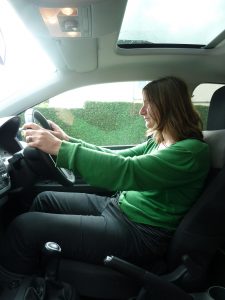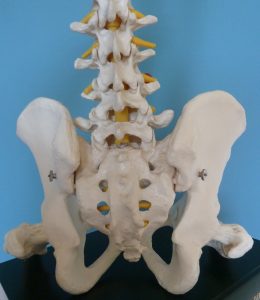 If you usually have to drive to work, you may be looking forward to having a break from your daily commute (even if you’re facing a long drive home for Christmas first). For all too many of us, driving contributes to, or even causes, back, neck or shoulder pain, as well as stress. How can the Alexander Technique make the daily commute a bit easier? Here are some things to think about and try out at home over the festive break.
If you usually have to drive to work, you may be looking forward to having a break from your daily commute (even if you’re facing a long drive home for Christmas first). For all too many of us, driving contributes to, or even causes, back, neck or shoulder pain, as well as stress. How can the Alexander Technique make the daily commute a bit easier? Here are some things to think about and try out at home over the festive break.
 How are you sitting?
How are you sitting?
Car seat design has a lot to answer for but even with the best seat in the world, it’s still easy to end up with aches and pains. The most important factor is not the seat but yourself and your ‘human ergonomics’. This is where the Alexander Technique can be so helpful. An Alexander teacher can enable you to discover how to drive with less effort and stress, sitting easily in balance, holding the steering wheel with less tension, and ‘rising above’ the antics of fellow road users.
If you’re trying to sit up straight or hold yourself upright then you’re not on the right track. Good posture − like that seen in most toddlers − is effortless. It does take time, and Alexander work, to wake up the deep postural muscles that are the hallmark of a ‘strong back’, but a good start is to develop an awareness of your sitting bones and the support coming from underneath. So, find a reasonably firm chair to sit on and slide your hands under your bottom from each side so that you’re briefly sitting on your hands. Can you feel the bony parts of yourself that you’re sitting on? These are our sitting bones, the rocker-shaped bottom of the pelvis (see photos). Now you’ve found them, take your hands away and try gently shifting yourself forwards or backwards to get a sense of how to balance on them, allowing your weight to drop straight down through the chair. Can you get a sense of the support coming up from the ground through the seat and up through your sitting bones? It’s this support that triggers our reflexes that send us upright.

Skeleton driver nicely balanced on its ‘sitting bones’
 Close-up of the back of the pelvis and lower spine. Note the ‘sitting bones’ in full contact with the supporting surface below and in balance
Close-up of the back of the pelvis and lower spine. Note the ‘sitting bones’ in full contact with the supporting surface below and in balance
How are you seeing?
Modern lifestyles, particularly the widespread use of mobile technology, are having the effect of narrowing our attention and visual field. Our vision is becoming more like a spotlight that focuses only on the specific object that our attention is currently on. This way of seeing can become a habit, and one which is certainly not helpful when driving! A safe driver is aware of everything around the current focal point, so that while looking at the road ahead, they will still immediately see movement at the periphery of their vision, such as if the door of a parked car they’re about to pass begins to open.
If your visual field seems quite narrow or two-dimensional and you’re interested in improving it, begin by spending a few minutes each day – perhaps looking out the window, or when you’re out on a walk – allow yourself to look at an object with a soft lively gaze, and notice the shapes, colours etc of what’s around it (these won’t be in focus). Don’t experiment with this when driving in case it distracts you – wait till you’ve developed the skill. This more natural, ‘panoramic’ (more three-dimensional) vision will pay dividends in whatever you’re doing through increased awareness and better balance.
How are you thinking?
No doubt, you’ll be familiar with the stress of trying to get to an appointment in time and being delayed by traffic. And as anyone who sufferers from chronic pain knows, stress makes it worse. The Alexander Technique helps us to shift our attention onto prioritising ‘looking after ourselves’ (keeping our poise) rather than over-focussing on the goal of getting there on time.
Another unwelcome aspect of driving is other drivers behaving selfishly or aggressively. The next time another driver does something that annoys you, see if you can take a second and, rather than just reacting unthinkingly, continue to keep your awareness of the road ahead, and at the same time notice the support of the seat coming up through your sitting bones and think of the distance up to the crown of your head and beyond. Then slowly and gently exhale through your lips, as if you were blowing a small feather away. Repeat a couple of times, noticing the in-breath automatically coming in through the nose and the continuous cycle of breath with no holding between the inbreath and the outbreath. Now decide whether or how you’d like to respond.
I hope you’ll enjoy exploring these ideas and discovering a more comfortable, calmer and less effortful way of driving.
Adapted from a previous article for BackCare’s Talkback magazine: Is your daily commute driving you to despair?; read the article for tips on how to adjust your car seat so that you can sit comfortably.